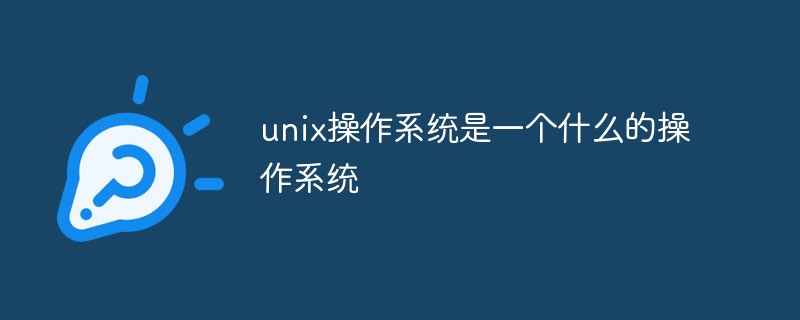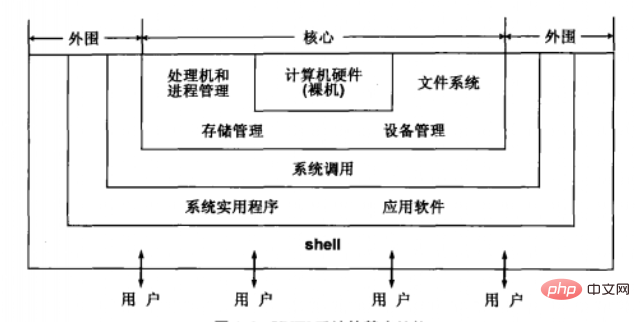What kind of operating system is unix operating system?
The unix operating system is a multi-user, multi-tasking, interactive time-sharing operating system. It provides users with a simple, efficient and flexible operating environment. The UNIX system provides a good user interface, which is easy to use, fully functional, clear and flexible, and easy to expand and modify; the file system of the UNIX system is a tree structure.

#The operating environment of this tutorial: Unix system, Dell G3 computer.
UNIX is a multi-user, multi-tasking, interactive time-sharing operating system, which provides users with a simple, efficient and flexible operating environment.
Most Unix systems are written in C language, providing rich and carefully selected system calls, providing a powerful programmable Shell language (shell language) as the user interface, and using a tree file system It has good security, confidentiality and maintainability, provides a variety of communication mechanisms, adopts the memory management mechanism of process swapping and the storage management method of request paging to realize virtual storage management. However, Unix does not implement centralized management of network resources on a "domain" basis, which is a characteristic of Windows NT.
UNIX system occupies an important position in the history of the development of computer operating systems. It has indeed continued to meticulously, carefully and selectively inherit and transform existing technologies, and has made some progress in the overall design concept of the operating system, which has made it such a great success. The main characteristics of the UNIX system are reflected in the following aspects:
(1) The UNIX system is structurally divided into two parts: the core program (kernel) and the peripheral program (shell), and the two are organically combined into a whole. The core part is responsible for the functions of each module within the system, namely processor and process management, storage management, device management and file system. The core program is characterized by careful design, conciseness and leanness. It only takes up a small space and is resident in the memory to ensure the high efficiency of the system. The peripheral part includes the system's user interface, system utilities and applications, through which users use the computer.

(2) The UNIX system provides a good user interface, which is easy to use, fully functional, clear and flexible, and easy to expand and modify. There are two forms of use of the UNIX system: one is the operating command, that is, the shell language, which is the interface through which users can interact with the system through the terminal; the other is the interface for user programs, which is not only in assembly language, but also in Provide services to users in C language.
(3) The file system of UNIX system is a tree structure. It consists of a basic file system and several removable sub-file systems, which can not only expand file storage space, but also facilitate security and confidentiality.
(4) The UNIX system handles files, file directories and devices in a unified manner. It treats files as character streams without any records for sequential or random access, and enables files, file directories and devices to have the same syntax and semantics and the same protection mechanism, which not only simplifies the system design, but also facilitates user use.
(5) The UNIX system contains a very rich set of language processing programs, utility programs and tool software for software development, providing users with a fairly complete software development environment.
(6) Most of the programs in the UNIX system are programmed in C language, and only about 5% of the programs are programmed in assembly language. C language is a high-level programming language, which makes UNIX systems easy to understand, modify and expand, and has very good portability.
(7) The UNIX system also provides simple communication functions between processes.
If you want to read more related articles, please visit PHP Chinese website! !
The above is the detailed content of What kind of operating system is unix operating system?. For more information, please follow other related articles on the PHP Chinese website!

Hot AI Tools

Undresser.AI Undress
AI-powered app for creating realistic nude photos

AI Clothes Remover
Online AI tool for removing clothes from photos.

Undress AI Tool
Undress images for free

Clothoff.io
AI clothes remover

AI Hentai Generator
Generate AI Hentai for free.

Hot Article

Hot Tools

Notepad++7.3.1
Easy-to-use and free code editor

SublimeText3 Chinese version
Chinese version, very easy to use

Zend Studio 13.0.1
Powerful PHP integrated development environment

Dreamweaver CS6
Visual web development tools

SublimeText3 Mac version
God-level code editing software (SublimeText3)

Hot Topics
 1378
1378
 52
52
 The difference between H5 and mini-programs and APPs
Apr 06, 2025 am 10:42 AM
The difference between H5 and mini-programs and APPs
Apr 06, 2025 am 10:42 AM
H5. The main difference between mini programs and APP is: technical architecture: H5 is based on web technology, and mini programs and APP are independent applications. Experience and functions: H5 is light and easy to use, with limited functions; mini programs are lightweight and have good interactiveness; APPs are powerful and have smooth experience. Compatibility: H5 is cross-platform compatible, applets and APPs are restricted by the platform. Development cost: H5 has low development cost, medium mini programs, and highest APP. Applicable scenarios: H5 is suitable for information display, applets are suitable for lightweight applications, and APPs are suitable for complex functions.
 Can I install mysql on Windows 7
Apr 08, 2025 pm 03:21 PM
Can I install mysql on Windows 7
Apr 08, 2025 pm 03:21 PM
Yes, MySQL can be installed on Windows 7, and although Microsoft has stopped supporting Windows 7, MySQL is still compatible with it. However, the following points should be noted during the installation process: Download the MySQL installer for Windows. Select the appropriate version of MySQL (community or enterprise). Select the appropriate installation directory and character set during the installation process. Set the root user password and keep it properly. Connect to the database for testing. Note the compatibility and security issues on Windows 7, and it is recommended to upgrade to a supported operating system.
 Can mysql and mariadb coexist
Apr 08, 2025 pm 02:27 PM
Can mysql and mariadb coexist
Apr 08, 2025 pm 02:27 PM
MySQL and MariaDB can coexist, but need to be configured with caution. The key is to allocate different port numbers and data directories to each database, and adjust parameters such as memory allocation and cache size. Connection pooling, application configuration, and version differences also need to be considered and need to be carefully tested and planned to avoid pitfalls. Running two databases simultaneously can cause performance problems in situations where resources are limited.
 Unable to log in to mysql as root
Apr 08, 2025 pm 04:54 PM
Unable to log in to mysql as root
Apr 08, 2025 pm 04:54 PM
The main reasons why you cannot log in to MySQL as root are permission problems, configuration file errors, password inconsistent, socket file problems, or firewall interception. The solution includes: check whether the bind-address parameter in the configuration file is configured correctly. Check whether the root user permissions have been modified or deleted and reset. Verify that the password is accurate, including case and special characters. Check socket file permission settings and paths. Check that the firewall blocks connections to the MySQL server.
 How to use locally installed font files on web pages?
Apr 05, 2025 pm 10:57 PM
How to use locally installed font files on web pages?
Apr 05, 2025 pm 10:57 PM
How to use locally installed font files on web pages Have you encountered this situation in web page development: you have installed a font on your computer...
 How to control the top and end of pages in browser printing settings through JavaScript or CSS?
Apr 05, 2025 pm 10:39 PM
How to control the top and end of pages in browser printing settings through JavaScript or CSS?
Apr 05, 2025 pm 10:39 PM
How to use JavaScript or CSS to control the top and end of the page in the browser's printing settings. In the browser's printing settings, there is an option to control whether the display is...
 Solutions to the errors reported by MySQL on a specific system version
Apr 08, 2025 am 11:54 AM
Solutions to the errors reported by MySQL on a specific system version
Apr 08, 2025 am 11:54 AM
The solution to MySQL installation error is: 1. Carefully check the system environment to ensure that the MySQL dependency library requirements are met. Different operating systems and version requirements are different; 2. Carefully read the error message and take corresponding measures according to prompts (such as missing library files or insufficient permissions), such as installing dependencies or using sudo commands; 3. If necessary, try to install the source code and carefully check the compilation log, but this requires a certain amount of Linux knowledge and experience. The key to ultimately solving the problem is to carefully check the system environment and error information, and refer to the official documents.
 Do mysql need to pay
Apr 08, 2025 pm 05:36 PM
Do mysql need to pay
Apr 08, 2025 pm 05:36 PM
MySQL has a free community version and a paid enterprise version. The community version can be used and modified for free, but the support is limited and is suitable for applications with low stability requirements and strong technical capabilities. The Enterprise Edition provides comprehensive commercial support for applications that require a stable, reliable, high-performance database and willing to pay for support. Factors considered when choosing a version include application criticality, budgeting, and technical skills. There is no perfect option, only the most suitable option, and you need to choose carefully according to the specific situation.



